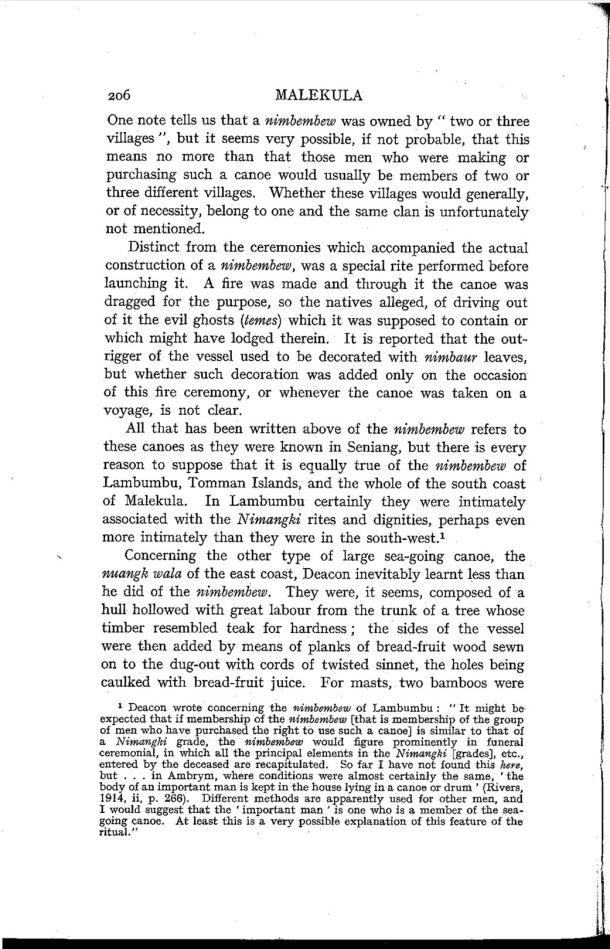|
|  [Note: this transcription was produced by an automatic OCR engine]
206 MALEKULA
One note tells us that a nimbembew was owned by " two or three
villages ", but it seems very possible, if not probable, that this
means no more than that those men who were making or
purchasing such a canoe would usually be members of two or
three different villages. Whether these villages would generally,
or of necessity, belong to one and the same clan is unfortunately
not mentioned.
Distinct from the ceremonies which accompanied the actual
construction of a nimbembew, was a special rite performed before
launching it. A ï¬Åre was made and through it the canoe was
dragged for the purpose, so the natives alleged, of driving out
of it the evil ghosts (temes) which it was supposed to contain or
which might have lodged therein. It is reported that the out~
rigger of the vessel used to be decorated with nimbaur leaves,
but whether such decoration was added only on the occasion
of this ï¬Åre ceremony, or whenever the canoe was taken on a
voyage, is not clear.
All that has been written above of the nimbsmbew refers to
these canoes as they were known in Seniang, but there is every
REASON to suppose that it is equally true of the nimbembew of
Lambumbu, Tomman Islands, and the whole of the south coast
of Malekula. In Lambumbu certainly they were intimately
associated with the Nimangki rites and dignities, perhaps even
more intimately than they were in the south-west}
Concerning the other type of large sea~g0ing canoe, the
mnmgk wala of the east coast, Deacon inevitably learnt less than
he did of the nimbembem. They were, it seems, composed of a
hull hollowed with great labour from the trunk of a tree whose
timber resembled teak for hardness; the sides of the vessel
were then added by means of planks of bread-fruit wood sewn
on to the dug-out with cords of twisted sinnet, the holes being
caulked with bread-fruit juice. For masts, two bamhoos were
1 Deacon wi-are concerning the flimlnmluw of Lambumhu: " It might he
expected that if membership oi the nimbamluw [that is membership of the group
oi men who have pll'Ch8.5ed the right to use such a canoe] is similar to that oi
a Nimtmgki grade, the ninzbembmv would ï¬Ågure prominently in funeral
ceremonial, in which all the principal elements in the Nimrmgki [grades], ebc.,
entered by the deceased are recapitulated. So far I have not iound this hum,
but . . . in Ambrym, where conditions were almost certainly the same, ‘the
body of an important man is kept in the house lying in a canoe or drum ’ (Rivers,
1914, ii, p. 266). Diï¬Åerent methods are apparently used for other men, and
I would suggest that the ‘important man ‘ is one who is a member of the sea-
going canoe. At least this is a very possible explanation oi this feature of the
ritual." >
mimi-
|